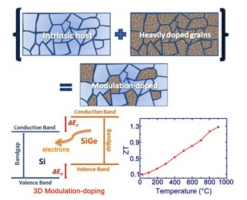-

Thermionics- First Principles based Theory
Read NowA graphene/phosphorene/graphene heterostructure in contact with gold electrodes is studied by using density functional theory (DFT)-based first-principles calculations combined with real space Green's function (GF) formalism. We show that for a monolayer phosphorene, quantum tunneling dominates the transport. By adding more phosphorene layers, one can switch from tunneling-dominated transport to thermionic-dominated transport, resulting in transporting more heat per charge carrier, thus, enhancing the cooling coefficient of performance.
-

Graphene Coolers
Read NowHow Graphene Could Cool Smartphones, Computers, and Other Electronics Chips
Graphene has a record-high thermal conductivity. We have shown that it also has a record high thermoelectric power factor. While large thermal conductivity enables passive cooling, a large thermoelectric power factor enables active cooling. The combination of passive and active cooling enables graphene to be an effective cooler for nanoscale applications.
-

Electronic Cloaking
Read NowWe found the proper conditions under which invisible nanoparticles are possible to make. The nanoparticles are invisible to the conduction electrons in the sense that the scattering cross-section of the electrons off of nanoparticles is 10000 times smaller than the geometrical limit
Nanoparticles in hiding PRL synopsis
"Invisibility" could be a key to better electronics, MIT NEWS
-

Integrated Coolers
Read NowMultifunctional Materials Integration: Cooler Chips Mean Smaller Devices
This article tells the story of the small coolers and why we need them. It highlights how our research group approches the problem.
-

Focus: Two Types of Cooling Require Different Designs
Read NowKeeping food cold is thermodynamically different from cooling a hot circuit element—a distinction that is accounted for in the design of a new thermoelectric cooler.
-

Thermoelectric Semimetals
Read NowSemimetals as potential thermoelectric materials,
Top 19 most-read article in physics in Nature Scientific Report in 2018
-
Women in Nanotechnology
Read NowSpringer Nature Switzerland AG, Cham, Switzerland, 2020, 140 pages, ISBN 978-3-030-19950-0
-

Modulation doping strategy applied to three dimensional nanostructured samples
Read NowModulation doping strategy applied to three dimensional nanostructured samples was developed to enhance the carrier mobility and the thermoelectric power factor. Below are some of the links to the media NEWS on this work. For more details, you can read our published articles in Nanoletters.